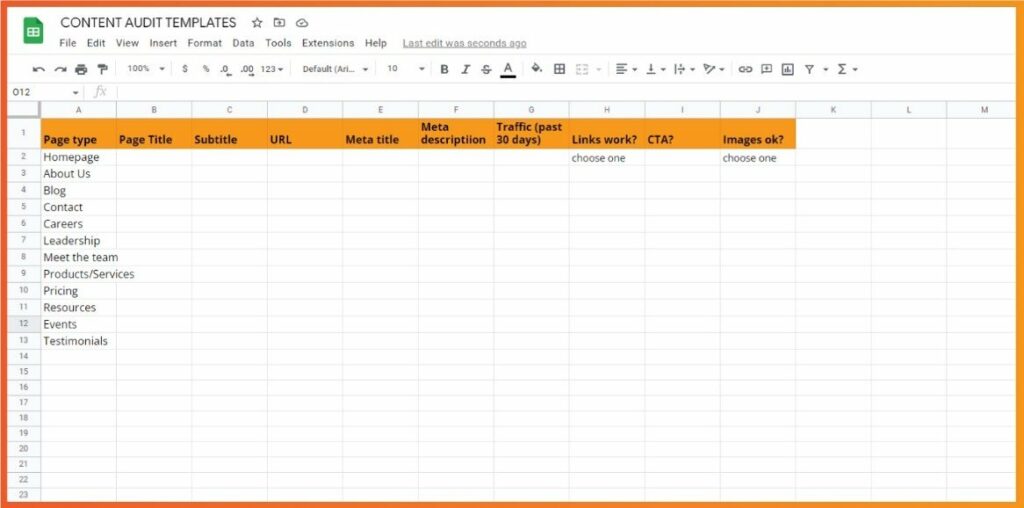In many cases, abundance may appear ideal, however, uncontrolled growth can stifle healthy development. The same goes for your website’s content. Over time, useful data might become buried beneath layers of old or irrelevant information. Here’s where content pruning comes in. Let’s have a look at this post to learn more about content pruning and how it benefits businesses.
Table of Contents
What Is Content Pruning?
Unlike repurposing, content pruning takes advantage of this process and offers convenience to website owners. Content pruning involves removing low-performing content from the website. In this process, you use different tools to identify obsolete content and allow relevant content to thrive.
As part of SEO’s requirements, websites must have valuable content to stand out in the search engine’s rankings. Cluttered and outdated content minimizes the chance of ranking potential, which may affect your website’s traffic.
For this purpose, it is an essential practice to apply content pruning, as it helps streamline browsing as well as improve the user experience. Aside from that, it tells search engines that your website contains useful material that users are likely to be interested in.
So, if you want to boost your website’s online presence and credibility, consider content pruning. It is an investment in the long-term viability and success of your online presence.
Why Is Content Pruning Important?
Just like a physical store, your website is like an online storefront. You have to keep it clean and organized to attract more traffic. Similarly, content pruning is your help in removing junk from your website and offers various benefits that can enhance the website’s performance. Here are some benefits that this process offers to website owners when applied strategically:
Enhanced User Experience
Finding what you need might be a frustrating process. The same goes for cluttered websites. Obsolete data, broken links, and irrelevant content provide a confusing experience for visitors.
Content pruning removes these detours, allowing users to easily navigate your website and find the information they want. This translates to better user satisfaction and a greater likelihood of them returning or becoming paying customers.
Improve Search Engine Ranking
Search engines like websites that include high-quality, relevant information. When your website is crowded with outdated or sparse material, it sends off-base signals. Content pruning improves not just user experience but also your SEO positioning by presenting your site as a worthwhile resource.
Additionally, pruning can help maintain a strong “EAT” score (Expertise, Authoritativeness, and Trustworthiness) in the eyes of search engines. By lowering bounce rates (customers who quickly leave your site), you demonstrate that your content is relevant and significant to search queries. So, grab your advanced pruning shears and get ready to witness your SEO ranking improve.
Easy Website Navigation
Having plenty of content might be a sign of ability, but if it is disorganized, users lose track and leave. Consider this: roughly 35% of visitors abandon websites with confusing structures. Content pruning addresses this issue by removing low-quality material and clutter. This makes your excellent content stand out and helps users find what they need faster. You may even combine similar items for a more streamlined experience.
Improve Brand Reputation
Your website content shapes your brand image. Outdated or low-quality products can hurt your reputation. Content pruning makes a difference by highlighting your best and most important information. This creates a great user experience and leaves visitors with a strong impression of your brand. They’ll regard you as a reliable source and keep returning for more.
How To Prune Content of Your Website?
The hard part of content pruning is pruning itself. Here’re some strategies you must consider for pruning content:
Identify Low-Performing Content
Spotting low-quality content is key to an effective content pruning project. Here’s what to see: low traffic, poor deals conversions, and a need for links from other websites. Outdated information is another ruddy hail. To evaluate user encounters, check metrics like bounce rate and time spent on the page.

Google Analytics is your companion here. It uncovers how users are associated with your website. Tools like Google Search Console offer assistance to monitor rankings and recognize ranges for improvement. By centering on high-quality content that users adore, you can strategically prune low entertainers and boost your SEO in the long run.
Batch-Delete Pages
Batch-deleting low-performing pages is your secret weapon! It declutters your website, makes strides search engine execution, and makes a difference search engines discover your most important substance. This deciphers to higher rankings and superior navigation for visitors, driving to more organic traffic.
The key? A careful content review to recognize obsolete or powerless pages. Once you erase them, set up 301 diverts to direct visitors to the right places.
Do not forget to optimize titles and headers for your remaining content. Tools like Google Analytics offer assistance to track the effect of your pruning efforts. Industry specialists like Victor Dish (IBM) and Francesco Baldini (SEO expert) emphasize the significance of content pruning.
Remain Proactive For Content Decay
Prevent decay by routinely checking in on your website’s performance. Think of it like keeping up a solid plant – everything needs a little TLC now and then. Search engines cherish new, relevant information, and substance left untouched for a long time can become outdated and lose its viability.
By taking a proactive approach, like reviving your content each quarter, you can dodge the need for extreme pruning later on. This not only keeps your content profitable for users but moreover makes a difference you stay on top of search engine preferences.
Use 301 Redirect to Closest Page
If a pruned page had backlinks or pulled in traffic, it’s wise to set up a 301 redirect. This acts like a sending address in the advanced world, consistently coordinating clients who tap the old link to a more pertinent page on your website. Think of it as offering alternative options. You wouldn’t need someone strolling into a closed store with nowhere to go.
The key is to select a “close-matching” page, one that bargains with a comparative point. Also, if that page is pruned, you might divert them to a page around “lead generation conversion rates.” This guarantees a smooth user experience and dodges disappointing dead ends.
Updating Internal Links
Broken links are like roadblocks on your website, baffling users and ruining their journey. When you prune content, it’s vital to upgrade any internal links that point to the erased pages. By guaranteeing all internal links point to pertinent and existing pages, you keep up a smooth user experience. This not only keeps visitors locked in but also fortifies your website’s internal linking structure.
Collaboration Is Key
Numerous departments, like SEO, product development, and deals, might have a stake in the content. To guarantee a smooth process, get everybody on board! Some time recently you start pruning, clearly clarify your plan and its benefits to all involved groups. Tune in to their concerns and discover common ground.
Here’s an example, at IBM, they scheduled meetings with each affected group, pointing for 80% ascension. The key? Prioritizing collaboration. Even if you do not get everything you need, keeping everybody included cultivates belief and dodges roadblocks. After all, a united front is significant for a successful content pruning extent.
Refresh Old Content
A simple update can sometimes give an old piece new vitality. Consider updating your data with the latest statistics, trends, or industry changes. You can also experiment with text organization to improve readability.
Adding visuals such as infographics or videos might help to increase user engagement. This strategy is a win-win: you save time and resources while keeping your website’s content fresh and locked in.
Involve Your Team
Content pruning might include other departments other than content creators. Think SEO pros and designers – they might have a stake in the handle. The secret to a smooth pruning venture? Early communication.
Get everybody on board from the beginning and explain your objectives for pruning. This straightforwardness ensures everyone’s on the same page and avoids any barricades. It too helps anticipate pruning from clashing with any upcoming specialized projects on your website. By collaborating early, you can streamline the preparation and accomplish an effective content pruning activity.
Evaluate Your Content
Track key metrics before and after pruning. This incorporates checking if imperative pages are indexed by search engines and if the indexing process has gotten to be faster. See if search activity to your remaining high-quality content has progressed. Most vitally, is your website less demanding to navigate now? Can visitors discover valuable content easily?

Keep in mind, separating the exact impact of pruning can be dubious, as it’s frequently done nearby other SEO improvements. Do not get debilitated by a lack of perfect data. See for clear and moderately speedy changes that can’t be easily attributed to other activities. A positive move in these measurements proposes your content pruning venture was a victory.
How Often Should You Prune Content?
Content pruning isn’t a one-time chore, but an ongoing process to keep your website’s content new and relevant. Think of it like weeding a plant – a small upkeep goes a long way. The world of SEO is always changing, with search engine algorithms, user preferences, and industry patterns advancing all the time.
Standard pruning ensures your content remains up-to-date and adjusts to these shifts. The perfect pruning plan depends on the measure of your website. For big websites with thousands of pages, aim for a quarterly (each 3 months) pruning session. For small websites, half-yearly pruning (each 6 months) is a good starting point
Key Tools For Content Pruning
Prevailing content pruning requires the right tools in your digital toolbox. Here are a few key players to streamline the process:
Traffic Analytics Tools (e.g., Google Analytics)
Disclose the hidden truths around your content’s performance. These tools track metrics like activity, bounce rate, and time on page, uncovering which content resounds with your audience and which needs a refresh.
Search Engine Ranking Tools
See where your content positions in search results. Tools like SEMrush or Ahrefs offer assistance to recognize low-ranking pages that might be dragging down your by and large SEO performance.
Content Audit Tools
These specialized tools can crawl your website and analyze your content based on various factors like length, recency, keyword usage, etc. They provide valuable insights for larger cleanup projects.
Website Crawler Tools
Think of these as digital inspectors. They crawl your entire website and identify broken links, duplicate content, and orphan pages (pages that aren’t linked to anywhere else).
A Key Piece of Your SEO Puzzle
Pruning content is not a standalone solution, but it is a critical component of a successful SEO strategy. Why? Removing low-quality content increases your website’s visibility in search results. The ideal frequency for pruning depends on the size of your site; every 3-6 months is a good starting point. But content pruning is only one piece of the SEO puzzle.
To achieve sustained success, you will need to master other areas such as competitor analysis, on-page SEO (optimizing your website’s content and structure), and technical SEO (ensuring the smooth functioning of your website). Boost your SEO efforts with our cutting-edge services, we’ll help you find your way there.



















